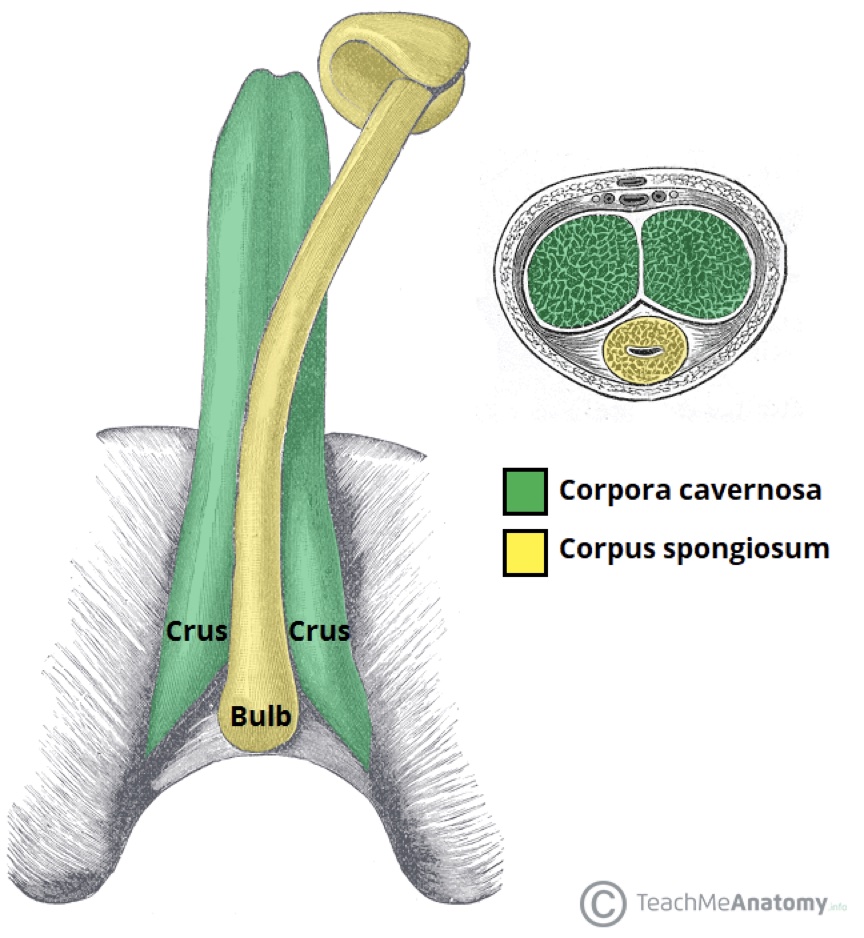Erectile dysfunction is a form of male sexual dysfunction. This is any physical or psychological problem that prevents you or your partner from getting sexual satisfaction. Male sexual dysfunction is a common health problem affecting men of all ages, but is more common with increasing age.
What Is Erectile Dysfunction?
Erectile dysfunction is defined as the persistent inability to achieve or maintain penile erection sufficient for satisfactory sexual performance. Although, some people will occasionally experience some difficulty with their penis becoming hard or staying firm some times in their life.
However, erectile dysfunction (ED) is often only a concern if satisfactory sexual performance is consistently impossible. It is important to note at this point that erections are not required for orgasms as many men with ED are able to reach orgasm or ejaculate through sexual stimulation or intercourse, even without an erection.
Anatomy Of The Penis and Erection
To understand erectile dysfunction, it’s important that one knows the anatomy of the penis and how erection happens.

The penis is composed of three cylinders encased in a sheath called the bucks fascia. These three cylinders are the corpus spongiosum (colored yellow in the picture) and two corpora cavernosa (colored green in the picture) known as the corpus cavernosum of penis.
The corpus cavernosum contains spongy erectile tissues with Cavernosal arteries running in the middle of each corpus cavernosa. The function of the corpus cavernosum is to facilitate penile erections. To achieve erection, the brain sends parasympathetic impulses to the nerves in the penis causing them to release neurotransmitters including gas nitric oxide, which relaxes the multiple muscles around the corpus cavernosum of the penis.
The arteries of the penis dilate and allows blood to flow in to the open spaces inside the corpora cavernosa. This blood creates pressure making the penis expand and compresses the veins that normally allow blood to drain. Once the blood is trapped, the corpora cavernosa helps to sustain the erection.
The corpus spongiosum, the spongy muscles surrounding the urethra itself remains spongy and limber to protect the urethra from closing during an erection. An erection is reversed once the muscles in the penis contract preventing blood flow in to the corpora cavernosa.
Please, note that in the flaccid state, these smooth muscles are tonically contracted, allowing only a small amount of arterial flow for nutritional purposes. The flaccid penis is therefore in a moderate state of contraction, as evidenced by further shrinkage in cold weather and after phenylephrine injection.
Types of Erection
These structures are responsible for the 3 types of erection Viz:
-
Psychogenic
Psychogenic erection is a result of audiovisual stimuli or fantasy.
-
Reflexogenic
Here erection is produced by tactile stimuli to the genital organs. This type of erection is preserved in patients with upper spinal cord injury.
-
Nocturnal
Erection occurs mostly during rapid-eye-movement (REM) sleep.
 Classification Of Erectal Dysfunction
Classification Of Erectal Dysfunction
There are 2 types of erectile dysfunction (ED):
-
Primary Erectile Dysfunction
The man has never been able to attain or sustain an erection. This is a very rare cause of erectile dysfunction.
The cause is not known.
-
Secondary Erectile Dysfunction
This is acquired later in life by a man who previously was able to attain erections and can be caused by the following:
-
Psychogenic causes
-
- Generalized
-
-
- Generalized unresponsiveness.
- Primary lack of sexual arousal.
- Age related decline in sexual arousability.
- Generalized unresponsiveness.
-
-
-
- Generalized inhibition
- Chronic disorder of sexual intimacy.
- Generalized inhibition
-
-
- Situational
-
-
- Partner related
- Lack of arousability in specific partner.
- Lack of arousability owing to sexual object preference.
- High central inhibition owing to partner conflict or threat.
- Partner related
-
-
-
- Performance related
- Associated with other sexual dysfunction (e.g. rapid ejaculation)
- Situational performance anxiety (fear of failure)
- Performance related
-
-
-
- Psychological disorders or adjustment related
- Associated with negative mood state (e.g. Depression, death of a partner etc.)
- Psychological disorders or adjustment related
-

-
Organic causes
-
- Vasculogenic(caused by disorder or dysfunction of the blood vessels)
- Arteriogenic – A narrowed arterial lumen contributes to increased peripheral vascular resistance as in hypertension, High Cholesterol and obesity/Metabolic syndrome.
- Cavernosal (Venogenic) – Failure of adequate venous occlusion has been proposed as one of the most common causes of vasculogenic impotence (e.g. Peronei’s disease, old age, and diabetes) or traumatic injury in penile fracture. Also Acquired venous shunts – the result of operative correction of priapism – may cause persistent glans/cavernosum spongiosum shunting.
- Mixed
- Vasculogenic(caused by disorder or dysfunction of the blood vessels)
-
- Neurogenic
- Anatomy – Peronei’s Disease(PD) is the medical name for what is more commonly known as a bent or curved penis. This curvature occurs as a result of dense scar tissue that develops under the skin of the penis. It can also bring with it painful erections or erectile dysfunction. Also stroke, spinal cord compression and Diabetic retinopathy.
- Endocrine
- Low Testosterone – Erectile dysfunction also may be associated with both the hyperthyroid and the hypothyroid states
- Alcohol use disorder
- Neurogenic
Alcohol in small amounts improves erection and increases libido because of its vasodilatory effect and the suppression of anxiety, however, large quantities may result in central sedation, decreased libido and transient erectile dysfunction.
-
- Drugs
-
-
- Anti-Hypertensive – Methyldopa, beta-blockers, Thiazide diuretics, spironolactone etc.
- Cardiac failure drugs – digoxin
- Anti depressants
- Opioid Analgesics
- Anti Ulcer drugs – Cimetidine
- Cancer Chemotherapy
-
Diagnosing Erectile Dysfunction
Erectile dysfunction can be the presenting symptom of a Varity of diseases such as cardiovascular diseases, diabetes mellitus, High cholesterol (hyperlipidemia), hypertension, spinal cord compression, and pituitary tumors etc.
Therefore, a thorough history (Medical, sexual and psychological), physical examination and appropriate laboratory tests aimed at detecting these diseases should be performed
Investigations For Erectile Dysfunction
- Complete blood count (CBC).
- Lipid profile.
- Liver & Kidney function tests.
- Urinalysis.
- Nocturnal penile Tumescence (NPT) – This is a measure of the quality of a man’s night time erections.
- Penile Biothesiometry – The presence of normal skin sensation adequate to produce an erection is measured with this device.
- Erection hardness scale (EHS)
The Erection Hardness Scale (EHS), an easy-to-use, four-point scale for erectile dysfunction (ED). This provides a reliable measure of erection hardness.
-
- A score of 1 indicates that the penis is larger than normal, but not hard.
- 2 means the penis is hard, but not hard enough for penetration.
- 3 means the penis is hard enough for penetration but not completely hard,
- 4 indicates that the penis is completely hard and fully rigid.
Erectile Dysfunction (ED) Treatment
ED can be a sign of a serious health problem. In fact, any disease that affects hormone levels, smooth muscle tissue, or the nerves or arteries of the penis can contribute to ED.
 Several options are available viz.
Several options are available viz.
1. Counseling
2. Lifestyle Changes
Healthy lifestyle changes like quitting smoking, losing excess weight, and increasing physical activity may help some men regain sexual function or at least prevent further worsening of the condition. Discontinuing drugs with harmful side effects is another effective treatment if clinically appropriate.
3. Erectile Dysfunction Medications
Drugs for treating ED can be taken orally, injected directly into the penis, or inserted into the urethra.
4. Low Testosterone Treatment
Testosterone can improve libido in some men with low natural testosterone levels, but it is often ineffective for erections and patients may need other treatment for their ED
5. Surgical Approach
Surgical procedures to improve erections are the oldest and most well established treatment for ED and are performed for 3 reasons:
-
- To implant a device that can cause the penis to become erect.
- To reconstruct arteries and increase penile blood flow.
- To occlude veins that allow blood to leak out of the penis and cause ED.
6. Device Use (Vacuum)
Mechanical vacuum devices induce erections by creating a partial vacuum, which draws blood into the penis, engorging and expanding it.
7. Use Of Platelet Rich Plasma (PRP)
Platelet rich plasma injection into the erectile tissue of the penis can be an effective short-term treatment for the management of mild to moderate ED.
Conclusion
In conclusion, erectile dysfunction can be the presenting symptom of a variety of diseases such as cardiovascular diseases, diabetes mellitus, hyperlipidemia, hypertension, and spinal cord compression. No one cause may be involved independently. A cascade of issues (including psychological as well as organic) can lead the to the impotent state. A continued understanding of the organic causes of erectile dysfunction will allow the physician to discover therapies for correction as well as provide reassurance to the patient.

